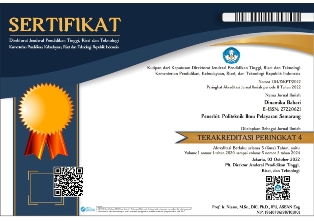Pengendalian Sanitasi Kapal Motor di Pelabuhan Tanjung Emas Semarang
Abstract
Sanitation is one of the efforts aimed at environmental risk factors on ships to break the chain of disease transmission in order to maintain and improve public health and maritime environment. This study aimed to determine the extent of the role of the master and crew in carrying out the provisions of MARPOL 73/78, annex IV and annex V in order to maintain the cleanliness of the ship and protect the maritime environment and to know the role of the Kantor Kesehatan Pelabuhan (KKP) in terms of providing waste disposal facilities or waste to control sanitation on board. The research method in discussing this problem uses qualitative methods. The qualitative method describes part of ships by inspecting and assessing how high the level of risk that can endanger the health of passengers onboard. Based on the results of the study, it can be concluded that Captain has been responsible for safety, smoothness and comfort of passengers on board and all crews always maintains sanitation on board and supervision of the provision of clean water and drinking water has been carried out in accordance with Standard Operating Procedures (SOP) by providing good facilities and infrastructure.
Downloads
References
Aryatie. (2005). Pentingnya Pemeliharaan Kebersihan dan Kesehatan di Atas Kapal dari Vektor Kecoa. Jakarta: SHE-C Division
Cahyani, C. A., Hanani, Y., & Sulistiyani, S. (2021). Relationship Between Sanitation Condition and Vector's Existence On Vessels at the Working Areas of Port Health Office (KKP) Class II Semarang in 2019. International Journal of Health, Education & Social (IJHES), 4(5), 11-19.
Hidayatsyah, M. (2012). Pengaruh Faktor Risiko terhadap Keberadaan Vektor Penyakit di Kapal pada Pelabuhan. Tembilahan. (Tesis Magister, USU). Diakses: http://repositori.usu.ac.id/handle/123456789/42445
Kemenkes. (2010). Permenkes No 492/Menkes/Per/IV/2010 Tentang Persyaratan Kualitas Air Minum. Peraturan Menteri Kesehatan Republik Indonesia
Marinda, D., & Ardillah, Y. (2019). Implementasi Penerapan Sanitasi Tempat-tempat Umum Pada Rekreasi Benteng Kuto Besak Kota Palembang. Jurnal Kesehatan Lingkungan Indonesia, 18(2), 89-97.
Moleong, L. (2017). Metode Penelitian Kualitatif. Remaja Rosdakarya.
Mouchtouri, V. A., Anagnostopoulou, R., Samanidou-Voyadjoglou, A., Theodoridou, K., Hatzoglou, C., Kremastinou, J., & Hadjichristodoulou, C. (2008). Surveillance study of vector species on board passenger ships, risk factors related to infestations. BMC Public Health, 8(1), 1-8.
Notoatmodjo, S. (2019). Metodologi Penelitian Kesehatan. Rineka Cipta.
Sihite. (2012). Sanitation and Hygiene. SIC.
Siswanto, H. (2012). Kamus Populer Kesehatan Lingkungan. EGC.
Sugiyono. (2017). Metode Penelitian Kuantitatif Kualitatif Dan R&D. Alfabeta.
Supriyadi. (2016). Faktor yang berhubungan dengan tingkat sanitasi pada kapal yang sandar di pelabuhan. Makara Kesehatan, 10(2) , 71-77
Suryani, D., & Hendrawan, A. (2020). Studi tentang Sanitasi Kapal. Saintara: Jurnal Ilmiah Ilmu-Ilmu Maritim, 4(2), 33-45.
Yunus, S. P. (2015). Hubungan personal higiene dan fasilitas sanitasi dengan kontaminasi Escherichia coli pada makanan di rumah makan padang Kota Manado dan Kota Bitung. JIKMU, 5(3), 210-220
Yuliawati, R., Wisnu Adi, P., Pramaningsih, V., & Rusdi, R. (2021). Analisis Sanitasi Kapal Dengan Tanda Keberadaan Kecoa Pada Kapal Penumpang Di Kantor Kesehatan Pelabuhan Kelas II Samarinda. Jurnal Ilmiah Manuntung, 7(1), 1-5














